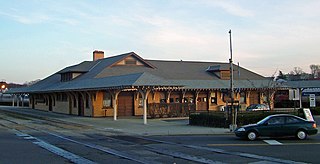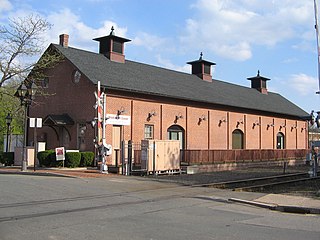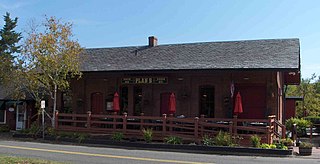
The New York and New England Railroad was a major railroad connecting southern New York State with Hartford, Connecticut, Providence, Rhode Island, and Boston, Massachusetts. It operated under that name from 1873 to 1893. Prior to 1873 it was known as the Boston, Hartford and Erie Railroad, which had been formed by several smaller railroads dating back to 1846. After bankruptcy in 1893, the New York and New England Railroad was reorganized and became known as the New England Railroad before its 1898 lease to the competing New York, New Haven and Hartford Railroad. Today, most of the original New York and New England lines have been abandoned; however a portion in Massachusetts is now part of the MBTA's Franklin Line providing commuter rail service to South Station in Boston. The Connecticut Southern Railroad operates freight service on a small portion of the former NY&NE line near East Hartford and Manchester, Connecticut. Other portions in Connecticut and Rhode Island have been converted to rail trails.

The Danbury Railway Museum is a railway museum housed in the former Union Station on the east end of downtown Danbury, Connecticut, United States. It was established in the mid-1990s following the closure of the station by the Metro-North Railroad, and primarily focuses on the history of railroading in southern New England and neighboring New York. In addition to the former station building, the museum has a collection of heritage railcars in the neighboring rail yard it shares with Metro-North.

The Waterbury Union Station building is located on Meadow Street in the city of Waterbury, Connecticut, United States. It is a brick building dating to the first decade of the 20th century. Its tall clock tower, built by the Seth Thomas Company, is the city's most prominent landmark.

Hartford Union Station is the main train station in Hartford, Connecticut, United States. The historic station building is near the State Capitol Building. It is a Richardsonian Romanesque building designed by George Keller, executed by Shepley, Rutan and Coolidge and built in 1889. A 1914 fire required a rebuild; the interior was renovated in 1987. It has been listed on the National Register of Historic Places since 1975.

The Connecticut Company was the primary electric street railway company in the U.S. state of Connecticut, operating both city and rural trolleys and freight service. It was controlled by the New York, New Haven and Hartford Railroad, which also controlled most steam railroads in the state. After 1936, when one of its major leases was dissolved, it continued operating streetcars and, increasingly, buses in certain Connecticut cities until 1976, when its assets were purchased by the state government.

New London Union Station is a historic regional rail station located in New London, Connecticut, United States. Located on the Northeast Corridor, the busiest railway in the United States, it is the primary railroad station in southeastern Connecticut. Union Station is a station stop for most of Amtrak's Northeast Regional trains and a small number of high-speed Acela Express trains. Certain ConnDOT Shore Line East commuter rail trains also stop at New London, making it the eastern terminus of commuter rail in Connecticut.

Windsor Locks is an Amtrak and ConnDOT train station in Windsor Locks, Connecticut, on the New Haven–Springfield Line. It is served by four Amtrak services - the Hartford Line shuttles, Northeast Regional, Valley Flyer, and Vermonter - as well as ConnDOT Hartford Line trains.

The Main Street Historic District in Danbury, Connecticut, United States, is the oldest section of that city, at its geographical center. It has long been the city's commercial core and downtown. Its 132 buildings, 97 of which are considered contributing properties, include government buildings, churches, commercial establishments and residences, all in a variety of architectural styles from the late 18th century to the early 20th. It is the only major industrial downtown of its size in Connecticut not to have developed around either port facilities or a water power site.

The Hartford & New Haven Railroad Freight Depot is a historic building at 40 Mechanic Street in downtown Windsor, Connecticut, across the street from the equally historic Hartford & New Haven Railroad Depot. Built about 1870, it is a well-preserved example of a Gothic Revival freight depot. It was listed on the National Register of Historic Places in 1988. It is now the home of the Windsor Arts Center, a non-profit place that exhibits the work of visual and performing artists.

Framingham is a historic Boston and Albany Railroad station located in downtown Framingham, Massachusetts. Designed by noted American architect H. H. Richardson, it was one of the last of the railroad stations he designed in the northeastern United States to be built. The station, built in 1884–85, served as a major stop on the B&A Main Line as well as a hub for branch lines to Milford, Mansfield, Fitchburg, and Lowell. After years of deterioration, the station was listed on the National Register of Historic Places in 1975 as the Framingham Railroad Station, and restored a decade later.

The Southbridge-Sargent Manufacturing District encompasses a collection of three 19th-century factory buildings near a historically important railroad junction in southern Worcester, Massachusetts. They were built near the intersection of Sargent and Gold Streets, just south of Southbridge Street. The location is close to a junction of three major railroads: the Boston and Albany, the Norwich and Worcester, and the New York, New Haven, and Hartford. The area was once a major industrial part of the city, but has lost many of its historic factory buildings in the 20th century.

Southbridge station is a former train station in Southbridge, Massachusetts. Built in 1910 by the New York, New Haven and Hartford Railroad (NYNH&H), it is a rare local example of Spanish Mediterranean architecture, and is the only surviving railroad building in the town. The building was listed on the National Register of Historic Places in 1989 as New York, New Haven & Hartford Passenger Depot. It presently serves as the town's senior center.

The Carroll Building in Norwich, Connecticut, also known as the Flat Iron Building, was built in 1887. It was listed on the National Register of Historic Places (NRHP) in 1982. It is included in the Downtown Norwich Historic District, which is also listed on the NRHP. Originally used as offices and retail stores, the building is now currently used primarily as an apartment building. The Carroll Building is located on a triangular tract created by the intersection of Main and Water Streets. The building is highly visible from Washington Square and is one of the most noticeable aspects of the downtown streetscape. The building is currently vacant.

The Telephone Exchange Building is a historic building at 23 Union Street in downtown Norwich, Connecticut, behind Norwich Town Hall. Built in 1906-07, it was the first purpose-built telephone exchange building in the city, and is a little-altered example of period exchanges built by the Southern New England Telephone Company. The building now houses city offices. It was listed on the National Register of Historic Places on November 28, 1983.

The Main Street Historic District No. 2 is a historic district in Hartford, Connecticut. It encompasses a city block in the city's downtown noted for its concentration of insurance-related highrise commercial buildings constructed in the early decades of the 20th century. It is visually dominated by the Travelers Tower, completed in 1919 and for many years Hartford's tallest building. The district was listed on the National Register of Historic Places in 1984, at which time it included seven contributing buildings over a nine-acre area.

The Greenwich Avenue Historic District is a historic district representing the commercial and civic historical development of the downtown area of the town of Greenwich, Connecticut. The district was listed on the National Register of Historic Places on August 31, 1989. Included in the district is the Greenwich Municipal Center Historic District, which was listed on the National Register the year before for the classical revival style municipal buildings in the core of Downtown. Most of the commercial buildings in the district fall into three broad styles, reflecting the period in which they were built: Italianate, Georgian Revival, and Commercial style. The district is linear and runs north–south along the entire length of Greenwich Avenue, the main thoroughfare of Downtown Greenwich, between U.S. Route 1 and the New Haven Line railroad tracks.

The Simsbury Railroad Depot is a historic railroad station at Railroad and Station Streets in the center of Simsbury, Connecticut. Built in 1875, it is a distinctive example of a railroad station with Italianate styling. The building was listed on the National Register of Historic Places on March 26, 1976. Presently, it houses a restaurant, called "Plan B".

The Engine Company 2 Fire Station is a firehouse at the corner of Main and Belden streets in Hartford, Connecticut, United States. It is a brick structure built in the early 20th century, the second firehouse built for the company. Architect Russell Barker, who designed many public buildings in the city, used the Italian Renaissance Revival style, unusual for a firehouse. The front facade boasts intricate brickwork. It is one of two remaining firehouses in the city originally designed to accommodate both men and horses. In 1989, it was added to the National Register of Historic Places along with several other city firehouses. It continues to serve its original function, housing Engine Company 2 of the Hartford Fire Department.

The Broad Street School is a historic former school building at 100 Broad Street in Norwich, Connecticut. The school was designed by New York City architect Wilson Potter and built in 1897. It is a well-executed and well-preserved example of Romanesque styling, and was the largest school built as part of a major construction program by the city. The schoolhouse was listed on the National Register of Historic Places on January 19, 1984. It has been converted to residential use.

The Hartford Municipal Building, also known as Hartford City Hall, is a historic Beaux-Arts structure located at 550 Main Street in Hartford, Connecticut. Completed in 1915, it is a prominent local example of Beaux-Arts architecture, and is the third building to serve as city hall. It was added to the National Register of Historic Places in 1981.






















